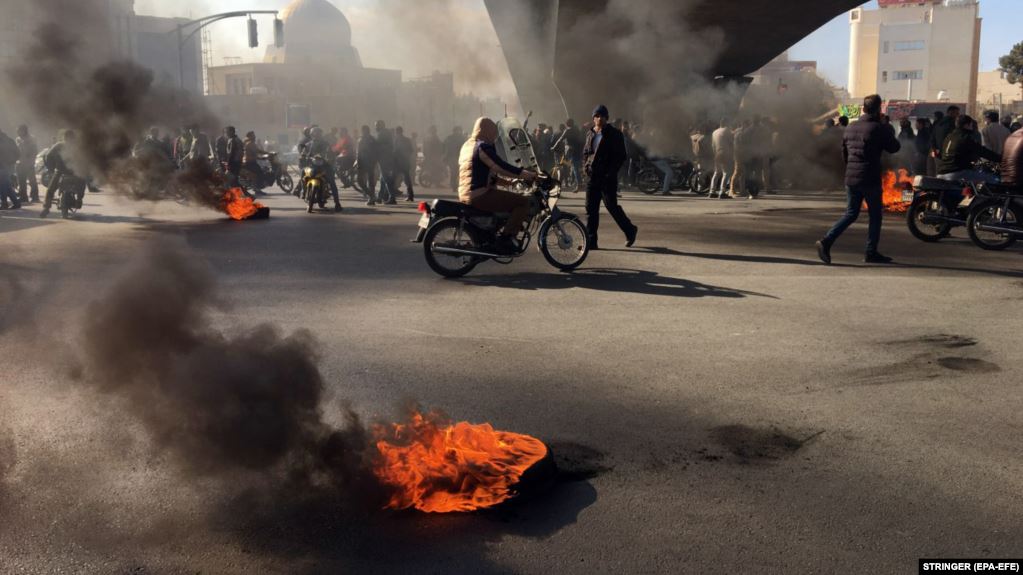Protests erupted In Iran last Friday, November 15, because of a sudden increase in gasoline prices. By Tuesday, the rights group Amnesty International stated that as many as 106 protesters in 21 cities had been killed in the rioting (Fassihi). This number is extremely high, especially compared to the mere 12 that Iranian news agencies reported were killed. These news agencies also state that hundreds of people have been injured, and more than a thousand have been arrested (Fassihi). But can these news agencies be trusted? These new set of protests are increasingly unique because of the control that Iran has displayed over communication and media.
The Iranian economic crisis that led to the increase in gas prices has a long history, tracing back to the United States. Most importantly, in 2015 Iran agreed to the Joint Comprehensive Plan of Action (JCPOA), otherwise known as the nuclear deal. This plan dictated that Iran would curb its nuclear program, which a United Nations watchdog would frequently check, in return for the lifting of many crippling economic sanctions imposed by the United States (Ahmadian). This plan functioned smoothly under the Obama administration, as the International Atomic Energy Agency “issued 15 reports confirming Iran’s full compliance” under the JCPOA (Mousavian). However, in 2018 President Donald Trump withdrew from the JCPOA and imposed new, harsh economic sanctions on Iran as part of his maximum pressure campaign to completely erase all nuclear capabilities and weaken Iran’s influence (“Averting the Middle East’s 1914 Moment”). Thus, Iran’s sudden increase in gasoline prices was in response to the tough economic crisis the country now faces, which Iran’s President, Hassan Rouhani, has called the worst in 40 years (Fassihi).
The protests have expanded around the country to various cities, where protesters have “attacked, ransacked and set fire to dozens of government buildings, including religious schools and municipal offices” (Fassihi). Demonstrators have also targeted state banks, calling them a symbol of their economic grievances (Fassihi). The supreme leader of Iran, Ayatollah Khamenei, has stated that the price increases on gas were necessary and appropriate. A newspaper that is a mouthpiece of Khamenei wrote that “‘thugs’ rioting in the streets should be executed by hanging” (Fassihi).
These riots, however, are a little different than Iran has previously faced. On Sunday, the Iranian government completely shut down the internet nationwide. The shutdown was done in an attempt to stop the flow of information and kill the demonstrations. This is not the first time that Tehran blocked online access to stop the spread of information. Amir Rashidi, an internet security and digital rights researcher at the Center for Human Rights in Iran, stated that this occurred during the mass protests in December 2017 and January 2018. He reported that “as soon as they shut down Telegram, basically the protest was finished because people were not connected to each other and they couldn’t communicate” (Kottasová and Mazloumsaki). However, this shut down appears much more severe. On Tuesday, connectivity was down to four percent of normal levels (Kottasová and Mazloumsaki). NetBlocks, a non-governmental organization that monitors internet governance, reported that this is the most severe disconnection tracked in any country (Kottasová and Mazloumsaki). This is an extreme example of how in Iran connectivity to the rest of the world flows only through state controlled entities that act as bottlenecks.
The regulation of internet and media that Iran has demonstrated over the past week has been observed in other nations as well. Myanmar, China, India, Zimbabwe, and Venezuela (and other nations) have previously blocked the internet (Kottasová and Mazloumsaki). It signifies an epidemic around the world of governments depriving individuals of human rights to access information worldwide. This is a direct example of the menu of manipulation that authoritarian leaders use in order to control citizens and maintain power. Leaders are able to limit information and control the media in order to make it almost impossible for people to communicate with one another as well as spread awareness of oppression both domestically and internationally. The Iranian government is using this tactic in hopes of suppressing opposition to the current regime, because, as previously mentioned, Khamenei backs the increase in prices and feels as though “a retreat might be seen as a capitulation that would embolden the protesters” (Fassihi). A large fear by the Iranian government could stem from what we learned in class about the power of the internet in the Arab Spring in 2010. The use of Facebook drastically propelled the protesters’ movement and enacted real change, even if the overall movement was not very successful.
The current protests in Iran and
restriction on internet access marks a fairly new limitation on human rights in
the modern era. While internet is controlled in various ways across the globe,
by private organizations or government entities, the complete shutdown of it is
a drastic measure. This poses an interesting question; are people entitled to
internet access, and to what extent? The internet alone may not be the biggest
factor in this debate. Instead, the information that people are able to access
through means of the internet is. Would individuals still be able to gain
access to global and domestic information without the internet? This depends a
lot on the country, and if other forms of information, such as the press, are
limited as well. For Iranians, these demonstrations seem to give the world a
glimpse at their answer to these questions.
Works Cited
Ahmadian, Hassan. “The Iran-U.S. Escalation: Causes and Prospects.” Harvard Kennedy School Belfer Center, June 2019.
“Averting the Middle East’s 1914 Moment.” International Crisis Group, Aug. 2019.
Fassihi, Farnaz. “Iran’s ‘Iron Fist’: Rights Group Says More Than 100 Protesters Are Dead.” The New York Times, 19 Nov. 2019. NYTimes.com, https://www.nytimes.com/2019/11/19/world/middleeast/iran-protests.html.
Kottasová, Ivana, and Sara Mazloumsaki. “What Makes Iran’s Internet Blackout Different.” CNN, https://www.cnn.com/2019/11/19/middleeast/iran-internet-shutdown-intl/index.html. Accessed 20 Nov. 2019.
Mousavian, Seyed. “How Iran Sees Its Standoff With the United States.” Council on Foreign Relations, July 2019.


This blog post centers around the Iranian revolts that have taken place since the United States and Trump have pulled out of JCPOA and Iranian gas prices have gone up. The author explains that the government responded with a great amount of force but are getting directly in front of the narrative by limiting access to media services, while simultaneously restricting the media’s ability to report the truth. The author does a great job explaining how this is a method of ruling that is included in the menu of manipulation and discusses the corruption in Iran’s regime. While I believe this discussion provides solid insight into the fragility of Iran’s theocratic regime, I believe greater discussion could’ve been used about the use of violence on the part of the government. The internet aspect is important; however, I feel there is a significant amount of hypothetical discussion in that much of the essay focuses mainly on how media tampering is a powerful tool of manipulation.
I think some deeper discussion of manipulation throughout Iran could have been useful to explain the uprisings to understand how exactly the Iranian government strips people of rights and responds to demonstrations. In addition, you discuss the United States as a key player in the early parts, but never come back to them again. I think some attention to the pressure that the sanctions put on the government would have been useful to explain the struggle between the citizens and the government. Ultimately, the government had to raise prices because Iran is almost internationally isolated by sanctions put on them by the west. This essay look at the situation in too much of a “right or wrong” light, when it could perhaps focus more on the complexity of the situation and the dangers facing the Iranian government’s stability.